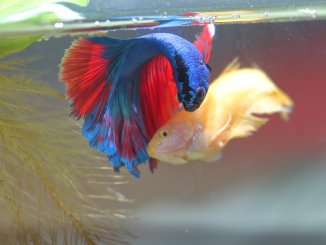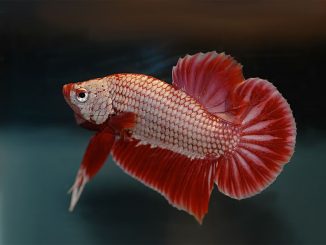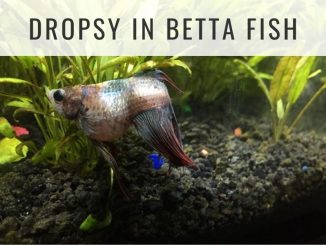
Betta fish, also known as Siamese fighting fish, labyrinth fish, or Betta splendens, are hugely popular among aquarium hobbyists. Known for their vibrant colors, feisty nature, and long, flowing fins, bettas are exceptionally beautiful fish.
Originally found in freshwater ponds and streams in Southeast Asia, betta fish have boomed in popularity. Extensive breeding has led to a wide variety of colors and tail fin styles, making betta fish a staple in any pet store.
However, betta fish are more difficult and expensive to care for than many first-time fish owners expect. Bettas are not starter pets, and they need proper care to thrive. Many betta fish are mistreated in the pet trade.
This betta fish guide will discuss everything you need to know about betta fish, including how to properly care for your betta fish.
TABLE OF CONTENTS
Betta Fish Facts & Overview

| Category | Rating |
| Care Level: | Moderate |
| Temperament: | Aggressive |
| Color: | Various colors, patterns, and shapes |
| Lifespan: | ~3 years |
| Size: | ~2.5 inches |
| Diet: | Carnivore |
| Family: | Osphronemidae |
| Minimum Tank Size: | 10 gallons |
| Tank Setup: | Freshwater, plants, caves |
| Compatibility: | None, or peaceful, shoaling species |
Bettas are a complex and fascinating breed. Here are some key facts to know about bettas before purchasing a betta fish:
- Scientific name: Betta splendens
- Family: Bettas are part of the Osphronemidae family. They are closely related to several other fish, such as gouramis.
- Environment/water type: Bettas need a varied and interesting freshwater environment, with plenty of places to hide and explore. Bettas prefer a low level of water disturbance, with a pH of 6.5-7. They also prefer warm water. Bettas are hardy fish and can tolerate poor water quality better than some other fish, but they only really thrive in good water conditions.
- Care level: Bettas are tough fish. If given the right environment, correct food, and suitable tank mates, they should be able to do well and live happily in your home.
- Temperament: Bettas are called “fighting fish” for a reason. Male bettas are particularly aggressive, especially towards other males or fish that look like other bettas. Females are more docile, but can still display aggression. You’ll need to choose your betta’s tank mates very carefully.
- Size: Betta fish grow up to 2–3 inches in length. The better you care for your betta fish, the larger and more vibrant it will become.
- Diet: Bettas are carnivorous fish, and eat insects in the wild. It can be difficult to provide betta fish with live food. Most fish owners buy commercial fish food designed specifically for a betta’s dietary needs.
- Minimum tank size: Bigger is better when it comes to tank size. The minimum tank size for a single betta is two gallons. Tiny, decorative fish bowls are not suitable for bettas — or indeed any fish.
- Tank setup: Bettas thrive in large tanks, with good water quality, regular cleaning, and plenty of decorations. A gentle air pump and an efficient water filter will keep the tank clean and in good condition.
- Min/max water temperature: Bettas prefer warmer water, ideally between 72–86°F.
- Compatibility: Male bettas do not get along well together, and should not be kept together. Bettas prefer docile tank mates, with subdued colors that can’t be mistaken for another betta. Aggressive tank mates that nip fins may attack your betta, and damage its long, flowing fins.
- Colors/Patterns: Bettas come in just about every color you can think of. Red, purple, blue, and white are among the most common colors, and most bettas are marbled, grizzled, or otherwise patterned. Solid-color bettas exist but are much rarer than patterned ones.
- Lifespan: The average lifespan for a betta fish in captivity is 2–4 years. However, with the right tank setup and proper care, your betta may well live even longer.
Betta Fish Appearance & Behavior

The colors and patterns of bettas vary. Generally, bettas are known for their long fins, flowing tails, and bright colors. They can be aggressive, and it’s important to match a betta with a suitable tank mate.
Types of Bettas by Appearance (Tail, Color, and Pattern)
Betta fish can be categorized by tail and fin shape, color, and pattern. Just about every color and pattern is available in most styles of tail shape.
Tail Shape
- Veiltail: the veiltail betta is the most common type of betta fish. Its fins are long and sleek, swooping downwards.
- Combtail: a combtail betta is a little fancier than the traditional veiltail. Its tail and fins taper to points, giving a ragged “comb” appearance.
- Crowntail: crowntail bettas are similar to combtails, with a more fringed edge to their fins and tails. The main difference between crowntails and combtails is that a crowntail’s fin webbing should reach at least two-thirds of the way down its fins.
- Halfmoon: halfmoon bettas are outstandingly beautiful, with majestic fins even when compared to regular betta fish. Their famous “halfmoon” tail fins fan out in a full 180 degrees, creating a half-circle shape.
- Double tail: just as its name implies, a double tail betta has two distinct and separate tail fins, giving it a unique shape.
- Delta: a delta betta is a more unusual type of betta, with its fins narrowing at the top of its body and fanning out at the tail fins. Deltas look similar to halfmoons, but their tails don’t quite reach the half-circle shape.

Color
Bettas can be found in all kinds of colors, with every combination and pattern you can imagine. Some colors are more popular than others, such as:
- Black
- Red
- Non-red (yellow)
- Blue
- Cellophane (clear)
- Albino
- Purple (rare)
Each color encompasses a range of shades and hues, leading to a completely unique color or combination of colors.
Pattern
Solid colored bettas do exist, but they tend to be rarer than patterned bettas. Some common patterns you might encounter are:
- Marbled: a marbled betta has half-light colors and half-dark colors on its body and fins, ideally with a noticeable contrast between the colors.
- Grizzled: a grizzled appearance creates an ethereal, iridescent effect on the bettas’ fins and body, with delicate strokes of color, like a paintbrush. Like the marbled betta, the ideal ratio of light to dark colors should be 50:50.
- Butterfly: similar to a bi-colored betta, butterfly bettas have one color on their bodies and another on their fins. The body color should seep into the fins, leaving a definite line on the fins.
- Bi-color: bi-colored bettas are very common, and are available in most varieties and combinations of color. The body of a bi-colored betta is one color, and the fins another.
The following are other common types of bettas:
- paradise betta
- plakat betta
- black orchid betta
- koi betta
- alien betta
- dragon scale betta
- giant betta
- glofish betta
- king betta
Betta Fish Behavior (Male vs Female)
Betta fish can be aggressive and territorial. They have strong personalities, which makes them fascinating to watch. There are some differences in how males and females behave, which can influence how and where you keep your bettas.
Male Bettas
Males betas are more territorial and aggressive than females. Here are some things to consider with a male betta fish:
- Never keep two males together, even in a large betta tank. They will likely fight to the death.
- Brightly colored fish with long fins can be mistaken for another male betta, leading to your betta attacking the fish.
- Even holding a mirror or a picture of another male betta up to the tank can cause a male betta to become aggressive towards the image, thinking that it’s another betta.
- Male bettas are solitary, and do very well in a tank by themselves.
- A male betta will build a bubble nest for potential offspring, even if there are no females around.
Female Bettas
Female bettas tend to be less aggressive, but you should still be careful. Territorial behavior does exist in females, and they may even fight with each other.
- Female bettas can safely be kept in groups of five or more, known as a sorority.
- Female bettas are less colorful than males and less territorial.
- If you are keeping a sorority, you should start with bettas of a similar age.
- Sororities still need plenty of space, to prevent territorial displays and aggression.
- Both male and female bettas have unique personalities, and not every female will be suitable for sorority life.
Proper Betta Fish Care and Tank Setup

Bettas are beautiful and fascinating pets, but if you intend to keep a betta, you should make sure it’s properly taken care of.
Proper betta fish care includes setting up a suitable tank, picking the right tank mates, and being careful to feed your betta fish the right food.
How to Set Up A Betta Fish Tank
Bettas need a minimum of two gallons of water, but more is always better. A five or ten-gallon tank is suitable, but bigger is always going to be better.
You will need to set up the tank several weeks before buying and introducing your betta, as all fish tanks need to cycle (the process in which good bacteria builds up in the tank, which deals with nitrate and ammonia levels that could hurt your fish) before you introduce living creatures.
To set up a betta fish tank, here’s what you’ll need:
- A fish tank (2, 5, or 10 gallons, or larger)
- Substrate (gravel or sand)
- A filtration system and air pump (heaters and thermostats are also recommended)
- Decorations (this includes hiding places, toys, and/or live plants)
Clean the tank and decorations first, but don’t use harsh chemicals or soaps. Try to make your aquarium a fun, inviting environment for your fish. Live plants can add extra oxygen to the water, and bettas love to explore.
Fill the tank with de-chlorinated water, turn on the filter and air pump, and let the tank cycle for a week or two.
Test the temperature. Remember, bettas prefer temperatures between 72–86°F, with a pH of 6.5–7. Once everything is set up, you can consider buying the fish.
Betta Fish Tank Mates
While bettas get on well with suitable tank mates, the wrong tank mate can lead to disaster. As long as you provide plenty of space in the tank, some good choices for betta tank mates include:
- Tetras (shoals of at least five)
- Corydoras catfish
- Kuhli loaches
- Snails
- Ghost shrimps
- Mollies
- Celestial pearl danios
- White Cloud Mountain minnows
- Glass catfish
- Yoyo loaches
Docile, bottom-feeding fish are the best match for bettas. Be careful of “fin nippers”, as they will be tempted to bite your betta’s long, flowing fins. This can lead to injury, stress, or even fin rot in your betta.
Betta Fish Food
Betta fish are carnivorous, so the best betta fish food contains protein. In the wild, bettas eat insects and small invertebrates such as larvae. You should feed your betta fish specially formulated betta flakes or pellets, as these pellets are designed to contain all the vitamins and meat a betta needs.
You can also feed your betta occasional treats, like brine shrimp and bloodworms. Like most fish, bettas are greedy and will overeat if you feed them too much.
Breeding Betta Fish

Male and female bettas should only be put together for breeding purposes, as the males will become aggressive towards the females.
Here’s what you should look for in suitable breeding bettas:
- Less than a year old — fertility drops after the betta’s first year of life
- Bright, vibrant colors in a male — this is most likely to attract females
- High energy levels in a female
- Excellent overall health in both the male and female betta
Regular water changes will mimic the rainy season in the bettas’ natural habitat, indicating that it’s time for the bettas to start breeding. 25% water changes twice weekly will do this.
Feed your bettas more frequently but in smaller amounts. Keeping the breeding tank bare and still, without using a strong air pump and filter, will help the fish to focus.
When you add the bettas to your tank together, keep them separate at first, with a clear plastic divider. The male betta should start building his bubble nest. Once the nest is ready, and you’re sure the female is interested, you can put the two fish together. Take the female betta out of the tank if you think she’s in danger.
After successful mating, the male betta will start collecting the eggs in the tank and taking them to the bubble nest. You should take the female betta out of the tank, then leave the male to take care of the eggs and the fry, once they hatch. Don’t feed your male while you wait for the eggs to hatch — it’s not unheard of for a first-time father to eat his own eggs.
Conclusion: Betta Fish are Not For Beginners
Betta fish require more complex and expensive care than many fish owners expect, and are not a suitable starter fish.
Betta fish require the following conditions:
- A fish tank (2, 5, or 10 gallons, or larger) with substrate, hiding places, and a filtration system
- A water temperature of 72–86°F, with a pH of 6.5–7
- Specially formulated betta flakes or pellets as food
- Tank mates that will not bite the betta’s long-flowing fins
Keeping betta fish in small tanks with unsuitable conditions is inhumane. You should also never keep male betta fish together because the fish are aggressive and can kill each other.
A PETA investigation exposed the poor conditions that many pet stores keep betta fish in, and how these fish are frequently mistreated in the pet trade. You should only buy a betta fish from a reputable retailer that prioritizes the fish’s health and wellbeing.
Betta fish are beautiful pets but are only suitable for experienced aquarists who can give these fish proper care and treat them humanely.
Reputable Betta Breeders
If you do decide to add betta fish to your tank, in order to ensure proper treatment and humane conditions for your betta, make sure to buy from a reputable, sustainable breeder. The following breeders put sustainability at the forefront of their businesses:
Betta Fish FAQs
These are the most frequently asked questions about betta fish:
- Can German blue rams live with bettas?
- Can betta fish live with Siamese algae eaters?
- Can you keep a rainbow shark with a betta?
- Can betta fish live with bristlenose plecos?
- Can platies be kept with bettas?
- Can bettas live with zebra danios?
- Can bettas live with kuhli loaches?
- Can a ghost shrimp live with a betta?
- Can plecos live with bettas?
- Can killifish live with bettas?
- Will bettas eat neon tetras?
- How can I tell if my betta is happy?
- What is a betta’s favorite food?
- Are betta fish easy to take care of?
- Will a betta kill a snail?
- Do bettas need a heater?
- Will a betta fish kill a turtle?
- Are bettas high maintenance?
- Can a betta fish live without a filter?
- What do bettas like in their tank?
- Do bettas like light?
- Do betta fish play dead?
- Do bettas like music?
- Why does my betta fish bite me?
- Do bettas eat moss balls?
- How do I know if my female betta is happy?
- Do betta fish like to be touched?
- Do betta fish recognize their owners?
- What can live with a betta?
- How can I play with my betta fish?
- Do betta fish get lonely?







Hi, new Betta owner here. I have kept water frogs over the years and also a few different types of fish. I had a 1 gallon tank already with decorations, gravel, everything I thought I needed. Got him home and realize my 3 gallon tank would be much nicer for him. I want to get rid of the gravel, and use tumbled crystal pebbles. Would this be ok for my Betta? Also have a heater and filter on the way. Should be here in 3 days. Is there anything I can do to keep the tank warm enough in the mean time?
I have my Elephant Ear BETTA in a 110 Gall. Community Tank with medium sized Discus, Neons, multible kinds of Cory Cats, Yoyo Loaches, Kuli Loaches, Glo Tetras and a 10 inch Pleco – all in perfect Harmony!!!